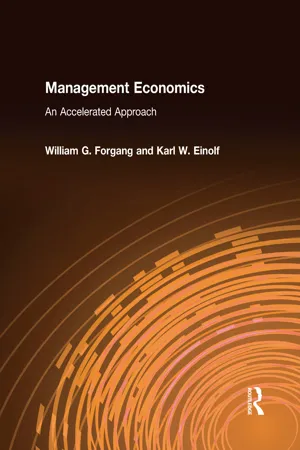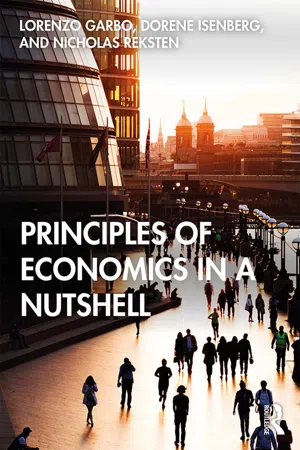Economics
Circular Flow of Income
The circular flow of income is a model that shows the flow of goods, services, and money in an economy. It demonstrates how households and firms interact through product and factor markets. In this model, households provide factors of production, such as labor and capital, to firms in exchange for income, which is then used to purchase goods and services.
Written by Perlego with AI-assistance
Related key terms
6 Key excerpts on "Circular Flow of Income"
- eBook - ePub
- A J Brown(Author)
- 2013(Publication Date)
- Routledge(Publisher)
CHAPTER 3 The Flows of MoneyMOST economies, as we have seen, are market economies in which individual families or productive enterprises do not produce most of what they themselves consume or store up, and do not themselves consume or store up most of what they produce—they sell most of their products for money and buy with money most of what they consume, or of what they add to their stocks of goods and equipment. In such an economy, therefore, most production is not simply an immediate attempt to meet the producers’ wants, and, except where production is centrally planned, the aggregate investment which comes about is not the result merely of decisions that so much ought to be accumulated. Between production on the one hand and consumption or accumulation on the other there intervene one or more exchanges of goods or services against money.The Circular FlowIn order to form a clear picture of the monetary machinery by which a market economy works, let us start with the simplest kind of situation, in which all output is produced by enterprises (not necessarily private) for sale, and in which there is no saving, no foreign trade, and no taxation. In such a community, a sum of money equal to the full value of output is paid out in each period by enterprises to the people who provide them with labour, capital, or materials, or who draw profits from them—that is to say, this sum is paid out to households. The whole of this money is then paid back by households to enterprises in exchange for the goods which they want to consume.Now, it can be seen that, if the volume of production does not change, a simple system of this kind can go on working indefinitely, with a constant amount of money. Ignore profits for a moment and suppose that all the payments connected with production consist of wages, salaries, and similar items which are paid out at the end of each week. Then what households have in hand at the beginning of this week will be precisely the cost of producing last week’s output, and by expending this sum during the week they can buy all of last week’s output at a price equal to its cost of production. Profits introduce a slight complication. In practice, of course, enterprises normally rely upon selling their output at a price which covers more than their out-of-pocket payments in connection with its production. If, however, we suppose that output is going on at the same level, week by week, the difficulty vanishes. It is true that there will not be enough money in households to buy last week's output at prices which allow for profits unless those profits have already been paid out, and that the profit on a particular batch of goods is not even earned until the goods are sold. With a constant output of goods week after week, however, there will always be some profits available in households to help buy the goods produced in the previous week, even though it is profit earned, not on those goods themselves, but on an earlier batch—perhaps the batch which was sold in the previous week and produced in the week before that. It is plain, then, that a steady stream of production, and its sale, can be financed by the circular flow of a fixed amount of money (how much is required we shall have to enquire later), between enterprises and households. If the volume of production is for any reason increased, there are further complications: the enterprises will have to find more money from somewhere to pay their increased wage-bill, etc., and households will also have to find some more in order to buy the first enlarged batch of goods in advance of receiving the enlarged profits on them; but that need not concern us at the moment. - eBook - ePub
- Neva Goodwin, Jonathan M. Harris, Julie A. Nelson, Pratistha Joshi Rajkarnikar, Brian Roach, Mariano Torras(Authors)
- 2018(Publication Date)
- Routledge(Publisher)
The two actors (households and firms) are represented by rectangles, the activity of exchange by the blue and gray arrows. Flows of goods or services create the clockwise flow of the outer circle. Households are considered the ultimate owners of all assets, including land (or natural resources), physical capital (such as factories and machinery), and financial capital. They supply the services of these assets, along with their labor, to firms via factor markets. (We’ll discuss exactly what we mean by “markets” in the next chapter.) Firms use these to produce goods and services, which return to the households via product markets. Households are consumers, buying and using these products. Flows of monetary funds, exchanged for these goods and services, move in the opposite direction around the inner circle. circular flow diagram: a graphical representation of the traditional view of an economy consisting of households and firms engaging in exchange factor markets : markets for the services of land, labor, and capital product markets : markets for newly produced goods and services ■ Figure 1.5 The Circular Flow Diagram This diagram is useful in portraying in a very simplified way two of the major actors (households and firms) and three of the major activities (production, exchange, and consumption) involved in economic life. However, it is important to recognize that the model leaves out some key actors and activities. For example, while “land” is included as a factor of production, the fact that natural resources can be used up or polluted is not portrayed. Because of this, the circular flow diagram is a little like a “perpetual motion machine”; the economy it portrays can apparently keep on generating products forever without any inputs of materials or energy. The necessity of wise resource management is not included. Also, the diagram only takes into account flows of goods or resources that are paid for through the market (the inner, gray arrows show these payments) - R. Sinha, Peter Pearson, Gopal Kadekodi, Mary Gregory(Authors)
- 2017(Publication Date)
- Routledge(Publisher)
Figure 2.1 , page 49) where the lines with arrows trace the income flows through the main economic processes of expenditure, production, the creation of value added and the distribution of personal incomes. Personal incomes as distributed across socioeconomic classes are divided, according to the consumption propensities of the various groups, between consumption expenditure, detailed by commodity, and personal savings. Consumption expenditure combined with the other, exogenous, elements of final demand takes up the outputs of the production sector. The production process engages factors of production, generating both employment and factor incomes. Factor incomes are divided into the after-tax incomes of the personal sector, on the one hand, and government and corporate incomes on the other. Personal incomes, as distributed across socio-economic classes by the production process and modified by the tax system, continue in the circular flow, to generate consumption expenditure. Non-personal incomes give rise to corporate and government savings which, together with the savings of the personal sector, form the total savings of the economy which can be checked, outside the model, against the capital requirements implicit in the production pattern.Figure 2.1 : Circular Flow Chart showing Income Flows Through Main Economic ProcessesFor the base year for our study, 1967–8, the figures used for all the constituent elements are the actual values for India in that year, adjusted to ensure numerical consistency throughout the model. At these values the flow of income through the system is self-replicating and we accept this as an equilibrium or solution of the model.In the aggregate, of course, expenditure, production and income generation are continuous and simultaneous processes and are appropriately represented as simultaneously determined. In these terms the model is a semi-closed Leontief system, semi-closed in that one of the elements of final demand, consumption expenditure, is endogenously determined through the level and distribution of personal incomes arising from the process of production. Applications of closed Leontief models in this area are rare, however, while the open model has been used on a number of occasions as a framework for assessing the impact of income redistribution on employment. A brief discussion of the open model may therefore be useful in setting the context for the partial closure incorporated in our variant.- eBook - ePub
Management Economics: An Accelerated Approach
An Accelerated Approach
- William G. Forgang, Karl W. Einolf(Authors)
- 2015(Publication Date)
- Routledge(Publisher)
2Aggregate Output, Prices, and Economic Indicators
This chapter develops a model of a free market economy, contributes to our understanding of the macroeconomic environment, and examines the determination of the economy’s aggregate output. Economic indicators are presented to help decision makers monitor the state of the economy and to align choices with the realities of the marketplace.Learning ObjectivesThe successful reader understands:• The nature of free market economies• The role of aggregate demand in the determination of aggregate output• How to use economic indicators to monitor the macroeconomy• The multiplier and the interactions between components of aggregate demand• The concept of aggregate supply and the relationship between aggregate supply, employment, and inflation• Fiscal policy and supply-side economic policy• How the macroeconomy affects business and personal decisionsThe Circular Flow of IncomeFigure 2.1 depicts a two-sector (households and businesses) market economy. Both participants are defined by their activities. Households own the resources used in the production process and express a force of supply in the resource market, and they use the income earned in the resource market to express a force of demand in the goods market. Businesses express a force of demand in the resource market based on the expectation of producing a good or service salable for profit, and they express a force of supply in the goods market to sell their products.The circular flow model is a useful tool in microeconomics. It shows the interactions between buyers and sellers and the role of the goods market and the resource market. The model assumes both households and businesses are motivated by self-interest. Households seek the highest possible payment for their resources and the lowest possible price for goods and services. Businesses have opposing objectives, seeking to pay the least for the resource inputs while realizing the highest price for their good or service. The interactions of the forces of supply and demand (examined more closely in Chapter 4 - eBook - ePub
- Lorenzo Garbo, Dorene Isenberg, Nicholas Reksten(Authors)
- 2020(Publication Date)
- Routledge(Publisher)
5Understanding the wealth of nationsNational income accounting5.1Circular flows and fundamental macroeconomic identitiesWe now need to shift our focus from a micro to a macro level. In the microeconomics section of the book we paid attention to the behavior of single agents of the economy, specifically the consumer and the producer (the firm). The variables we used were pertinent to these agents: fundamentally the relationships between price and quantity of goods and services, studied from the point of view of consumers and suppliers, respectively.A macroeconomic story, and some macroeconomic vocabulary
When we approach the macroeconomy, the aggregate economy of a country, a region, and so on, the functions of the various economic agents change, as agents are not seen only as relating to a specific market but become the integrated engines of the economy taken as a whole.Thus, households not only demand goods and services, but also supply labor and capital to the production processes of the country. In exchange, they receive income that can be used to purchase consumption goods and services, pay taxes, and add to the households’ savings. Households’ savings are placed in the financial sector : banks receive savings and turn them around in the form of lending to firms for their investments , i.e., to purchase capital goods that will further their production processes in the future. The amount of lending banks can do out of the savings they receive is regulated by the central bank (the Federal Reserve System in the US), and the economic policy implemented by the central bank of a country is known as monetary policy. Firms - eBook - ePub
American Hometown Renewal
Policy Tools and Techniques for Small Town Officials
- Gary A. Mattson(Author)
- 2016(Publication Date)
- Routledge(Publisher)
The community is composed of economic micro-units that produce and consume goods and services. As a producer, the community creates more economic micro-units than it consumes. As a consumer of goods and services, the community consumes more of some things than it is likely to produce. The local economy will attempt to rid itself of its surpluses while filling its deficits (Harmstrom, 1983, Ch.3). Known as the Circular Flow Model (or the rain barrel analogy), this economic behavioral tendency is a stylized illustration of how important economic linkages (resources of land, raw materials, and labor, and as well as products and commodities) interplay so that money flows both into and outside community’s regional boundaries. This concept is illustrated by a rain barrel “with money and goods flowing into the top as well as spilling out.” The barrel represents the community and its linkage to the outside world through the “inflow and outflow of income and goods.” The size of the barrel is “determined essentially by the inflow of outside income, the lack of leakage of income and the volume of resources used to produce the community’s output” (Hustedde, et al., 2005, p. 2). According to Darling (1991), the rain barrel is a static model of money flows. It visually represents a leaky rain water barrel where dollars can flow into the community (at the top) but may leak out from the holes in the barrel. The water line represents the community’s level of prosperity. Money will flow into the barrel two ways: (1) the products sold to outside customers (the export base), which allow a firm to earn new dollars; and (2) dollars flowing in from outside resources to the government and its local citizens in the form of income transfer payments, state or federal grants, or dividends from investment to local citizens—these new dollars are captured dollars that fill up the barrel. At the same time, money may flow out of the community
Learn about this page
Index pages curate the most relevant extracts from our library of academic textbooks. They’ve been created using an in-house natural language model (NLM), each adding context and meaning to key research topics.





